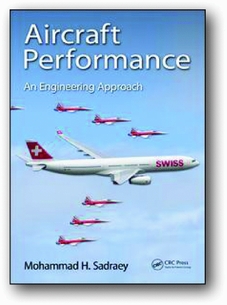
I was already familiar with Dr Sadraey's excellent book, Aircraft Design: A Systems Engineering Approach (John Wiley. 2013), so it was with considerable interest I read his new book titled, Aircraft Performance: An Engineering Approach.
My first impression was that it is a large book, probably bigger than most textbooks students already have on their bookshelves. However, the content of the book is really good and follows a clear and logical approach to aircraft performance.
After providing a description of the atmosphere, the book describes the equations of motion for aircraft. It then goes on to derive these equations in different phases of flight. Subsequent chapters describe the aerodynamic forces, and engine performance – it is also good to see some attention has been given to electric propulsion.
The later chapters use the equations of motion to determine the performance of an aircraft as it undertakes different manoeuvres including straight and level flight, climb and descent, take-off and landing, and lastly, turning performance and flight manoeuvres. There is then a final chapter on using numerical methods (as implemented and demonstrated in MATLAB) to analyse aircraft performance.
The level of detail in the book is impressive and the content of the earlier chapters most likely extends beyond what is taught in university courses on aircraft performance; it goes into the realms of aerodynamics, propulsion and aircraft design and shows how these disciplines are so closely connected.
The content in the later chapters is equally thorough, with sections describing the effect of headwind and runway slope on take-off being examples of this. The number of example questions with worked solutions is significant and will be of use to undergraduate students taking aircraft performance courses. The breadth of the book would also provide an excellent foundation for Masters level Aeronautics students from other engineering disciplines wanting to get up to speed with aircraft performance and aeronautics specific content more generally. The appendices include performance data on a range of aircraft, and most interestingly, an appendix on ‘Flight Records’, which includes some fascinating data.
The book is certainly comprehensive, with extensive examples, problems at the end of each chapter and MATLAB codes.


